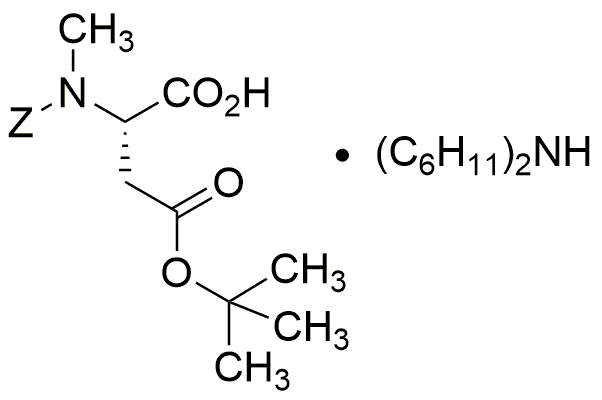Z-N-methyl-L-aspartic acid b-tert-butyl ester dicyclohexylammonium salt is widely utilized in research focused on:
- Neuroscience Research: This compound serves as a potent NMDA receptor agonist, making it valuable for studying synaptic transmission and neuroplasticity in various neurological conditions.
- Pharmaceutical Development: Its unique properties allow for the exploration of new therapeutic agents targeting cognitive disorders, providing a foundation for drug formulation and testing.
- Biochemical Assays: The compound is used in assays to evaluate enzyme activity and receptor interactions, aiding researchers in understanding metabolic pathways and drug interactions.
- Material Science: Due to its structural characteristics, it can be incorporated into polymers for creating advanced materials with specific functionalities, enhancing product performance.
- Analytical Chemistry: It is employed as a standard in chromatography and spectrometry, facilitating accurate quantification and analysis of related compounds in complex mixtures.
General Information
Properties
Safety and Regulations
Applications
Z-N-methyl-L-aspartic acid b-tert-butyl ester dicyclohexylammonium salt is widely utilized in research focused on:
- Neuroscience Research: This compound serves as a potent NMDA receptor agonist, making it valuable for studying synaptic transmission and neuroplasticity in various neurological conditions.
- Pharmaceutical Development: Its unique properties allow for the exploration of new therapeutic agents targeting cognitive disorders, providing a foundation for drug formulation and testing.
- Biochemical Assays: The compound is used in assays to evaluate enzyme activity and receptor interactions, aiding researchers in understanding metabolic pathways and drug interactions.
- Material Science: Due to its structural characteristics, it can be incorporated into polymers for creating advanced materials with specific functionalities, enhancing product performance.
- Analytical Chemistry: It is employed as a standard in chromatography and spectrometry, facilitating accurate quantification and analysis of related compounds in complex mixtures.
Documents
Safety Data Sheets (SDS)
The SDS provides comprehensive safety information on handling, storage, and disposal of the product.
Product Specification (PS)
The PS provides a comprehensive breakdown of the product’s properties, including chemical composition, physical state, purity, and storage requirements. It also details acceptable quality ranges and the product's intended applications.
Certificates of Analysis (COA)
Search for Certificates of Analysis (COA) by entering the products Lot Number. Lot and Batch Numbers can be found on a product’s label following the words ‘Lot’ or ‘Batch’.
Número de catálogo
Número de lote/lote
Certificates Of Origin (COO)
This COO confirms the country where the product was manufactured, and also details the materials and components used in it and whether it is derived from natural, synthetic, or other specific sources. This certificate may be required for customs, trade, and regulatory compliance.
Número de catálogo
Número de lote/lote
Safety Data Sheets (SDS)
The SDS provides comprehensive safety information on handling, storage, and disposal of the product.
DownloadProduct Specification (PS)
The PS provides a comprehensive breakdown of the product’s properties, including chemical composition, physical state, purity, and storage requirements. It also details acceptable quality ranges and the product's intended applications.
DownloadCertificates of Analysis (COA)
Search for Certificates of Analysis (COA) by entering the products Lot Number. Lot and Batch Numbers can be found on a product’s label following the words ‘Lot’ or ‘Batch’.
Número de catálogo
Número de lote/lote
Certificates Of Origin (COO)
This COO confirms the country where the product was manufactured, and also details the materials and components used in it and whether it is derived from natural, synthetic, or other specific sources. This certificate may be required for customs, trade, and regulatory compliance.


